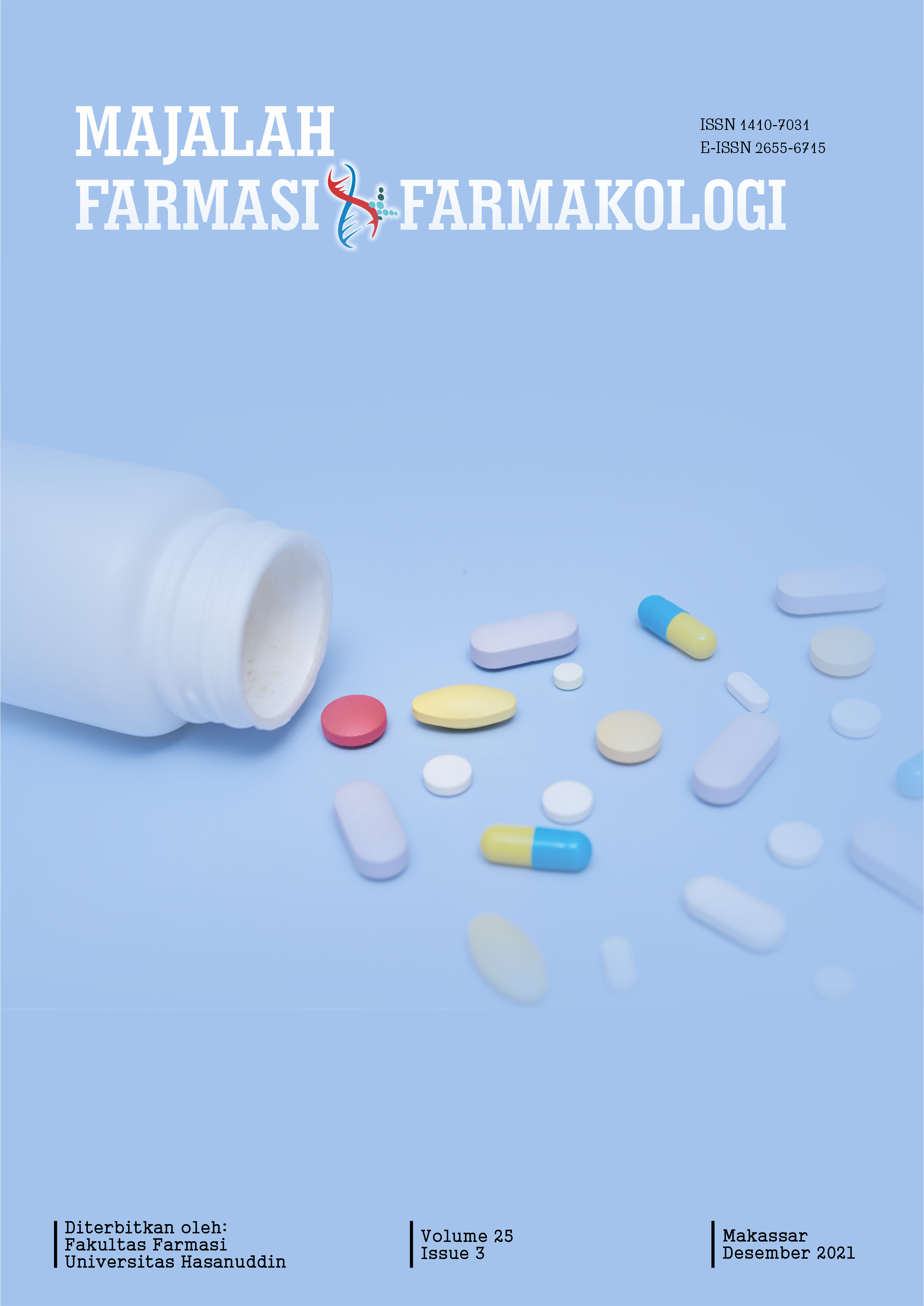POTENSI INTERAKSI OBAT PADA PASIEN COVID-19 DI SALAH SATU RUMAH SAKIT DI PROVINSI KALIMANTAN SELATAN
Keywords:
Covid-19, Keparahan, Potensi Interaksi Obat, Covid-19, Keparahan, Potensi Interaksi ObatAbstract
Coronavirus 2019 (COVID-19) adalah penyakit menular yang disebabkan oleh virus corona baru yang pertama kali diidentifikasi pada Desember 2019. Hingga saat penelitian ini dilakukan, belum ditemukan obat yang spesifik untuk penyakit COVID-19 sehingga pengobatan masih bersifat suportif dan simptomatik. Hal ini mengakibatkan pasien mendapatkan banyak obat/polifarmasi yang berpotensi berinteraksi. Tujuan dari penelitian ini untuk menganalisis potensi interaksi obat pada pasien Covid-19. Jenis penelitian ini adalah observasional retrospektif dengan metode analisis secara deskriptif. Penelitian dilakukan dengan cara mengumpulkan data dari Pusat Data Elektronik dan Rekam Medis pasien Covid-19 periode maret-agustus 2020. Pemeriksaan interaksi obat dilakukan melalui website Micromedex. Berdasarkan data yang diperoleh dari 114 rekam medis pasien Covid-19 didapatkan sebanyak 231 potensi interaksi obat. Untuk Kategori keparahan interaksi obat Minor (17 kasus), Moderate (151 kasus), Mayor (765 kasus) dan Contraindicated (20 kasus). Sementara untuk kategori onset interaksi obat Delayed (85 kasus), Rapid (71 kasus) dan Not Specified (797 kasus). Lima interaksi obat terbesar yaitu Azitromisin – Hidroksikloroquin (80 kasus), Azitromisin – Levofloxacin (62 kasus), Hidroksikloroquin – Levofloxacin (56 kasus), Aztromisin – Lovinapir dan Ritonavir (26 kasus) dan Azitromisin Moxifloxacilin (26 kasus).
References
Cennimo DJ. Coronavirus Disease 2019 (COVID-19) [Internet]. Ney York; 2020. Available from: https://emedicine.medscape.com/article/2500114-overview#a1
Sciaccaluga C, Cameli M, Menci D, Mandoli GE, Sisti N, Cameli P, et al. COVID-19 and the burning issue of drug interaction: Never forget the ECG. Postgrad Med J. 2021;97(1145):180–4.
WHO. Coronavirus [Internet]. 2020. Available from: https://www.who.int/health-topics/coronavirus#tab=tab_1
Center for Disease Control and Prevention. COVID-19 [Internet]. Atlanta; 2020. Available from: https://www.cdc.gov/coronavirus/2019-ncov/your-health/about-covid-19/basics-covid-19.html
Brandariz-Nuñez D, Correas-Sanahuja M, Guarc E, Picón R, García B, Gil R. Potential drug-drug interactions in COVID 19 patients in treatment with lopinavir/ritonavir. Med Clin (Barc). 2020;155(7):281–7.
Rezaee H, Pourkarim F, Pourtaghi-Anvarian S, Entezari-Maleki T, Asvadi-Kermani T, Nouri-Vaskeh M. Drug-drug interactions with candidate medications used for COVID-19 treatment: An overview. Pharmacol Res Perspect. 2021;9(1):1–18.
Mahboobipour AA, Baniasadi S. Clinically important drug–drug interactions in patients admitted to hospital with COVID-19: Drug pairs, risk factors, and management. Drug Metab Pers Ther. 2021;36(1):9–16.
Di Gennaro F, Pizzol D, Marotta C, Antunes M, Racalbuto V, Veronese N, et al. Coronavirus diseases (COVID-19) current status and future perspectives: A narrative review. Int J Environ Res Public Health. 2020;17(8).
Fauziah H, Mulyana R, Martini RD. Polifarmasi Pada Pasien Geriatri. Hum Care J. 2020;5(3):804.
Dasopang ES, Harahap U, Lindarto D. Polipharmacy and Drug Interactions in Elderly Patients with Metabolic Diseases. Indones J Clin Pharm. 2015;4(4):235–41.
Preskorn SH, Quadri S. Why Are Patients With COVID-19 at Risk for Drug-Drug Interactions? [Internet]. 2020. Available from: https://www.psychiatrictimes.com/view/why-patients-with-covid19-risk-drug-drug-interactions
Faizah AK, Nurrahman NWD, Putra ON. A Mini Review : Clinically Significant Potential Drug-Drug Interactions In COVID-19 and Comorbid Therapy. Pharm Sci Res. 2020;7(4):23–8.
Kumar D, Trivedi N. Disease-drug and drug-drug interaction in COVID-19: Risk and assessment. Biomed Pharmacother [Internet]. 2021;139:111642. Available from: https://doi.org/10.1016/j.biopha.2021.111642
Crescioli G, Brilli V, Lanzi C, Burgalassi A, Ieri A, Bonaiuti R, et al. Adverse drug reactions in SARS-CoV-2 hospitalised patients: a case-series with a focus on drug–drug interactions. Intern Emerg Med [Internet]. 2021;16(3):697–710. Available from: https://doi.org/10.1007/s11739-020-02586-8
Manjhi PK, Kumar R, Priya A. Drug-Drug Interactions in Patients with COVID-19: A Retrospective Study at a Tertiary Care Hospital in Eastern India. 2021;16(2):163–9.
Cattaneo D, Pasina L, Maggioni A Pietro, Giacomelli A, Oreni L, Covizzi A, et al. Drug–Drug Interactions and Prescription Appropriateness in Patients with COVID-19: A Retrospective Analysis from a Reference Hospital in Northern Italy. Drugs and Aging [Internet]. 2020;37(12):925–33. Available from: https://doi.org/10.1007/s40266-020-00812-8
Yeh ML, Chang YJ, Wang PY, Li YC, Hsu CY. Physicians’ responses to computerized drug-drug interaction alerts for outpatients. Comput Methods Programs Biomed [Internet]. 2013;111(1):17–25. Available from: http://dx.doi.org/10.1016/j.cmpb.2013.02.006
Lexicomp. Drug interactions [Internet]. Hudson; 2020. Available from: https://www.wolterskluwer.com/en/solutions/lexicomp/resources/facts-comparisons-user-academy/drug-interactions
Nachimuthu S, Assar MD, Schussler JM. Drug-induced QT interval prolongation: Mechanisms and clinical management. Ther Adv Drug Saf. 2012;3(5):241–53.
Jayasinghe R, Kovoor P. Drugs and the QTc interval. Aust Prescr. 2002;25(3):63–5.
Kauthale RR, Dadarkar SS, Husain R, Karande V V., Gatne MM. Considerations for Drug Interactions on QTc in Exploratory COVID-19 Treatment. J Appl Toxicol. 2015;35(7):799–805.
Mosholder AD, Mathew J, Alexander JJ, Smith H, Nambiar S. Cardiovascular risks with azithromycin and other antibacterial drugs. N Engl J Med. 2013 May;368(18):1665–8.
Yu T, Niu T. Giant inverted T waves and substantial QT interval prolongation induced by azithromycin in an elderly woman with renal insufficiency. Can Fam Physician. 2014 Nov;60(11):1012–5.
Ohara H, Nakamura Y, Watanabe Y, Cao X, Yamazaki Y, Izumi-Nakaseko H, et al. Azithromycin Can Prolong QT Interval and Suppress Ventricular Contraction, but Will Not Induce Torsade de Pointes. Cardiovasc Toxicol. 2015 Jul;15(3):232–40.
Owens RCJ, Nolin TD. Antimicrobial-associated QT interval prolongation: pointes of interest. Clin Infect Dis. 2006 Dec;43(12):1603–11.
Guo D, Cai Y, Chai D, Liang B, Bai N, Wang R. The cardiotoxicity of macrolides: a systematic review. Pharmazie. 2010 Sep;65(9):631–40.
Burns H, Russell L, Cox ZL. Statin-induced rhabdomyolysis from azithromycin interaction in a patient with heterozygous SLCO1B1 polymorphism. J Clin Pharm Ther. 2021;46(3):853–5.
Elsby R, Hilgendorf C, Fenner K. Understanding the critical disposition pathways of statins to assess drugdrug interaction risk during drug development: It’s not just about OATP1B1. Clin Pharmacol Ther. 2012;92(5):584–98.
Nahata M. Drug interactions with azithromycin and the macrolides: An overview. J Antimicrob Chemother. 1996;37(SUPPL. C):133–42.
Hache G, Rolain JM, Gautret P, Deharo JC, Brouqui P, Raoult D, et al. Combination of Hydroxychloroquine plus Azithromycin As Potential Treatment for COVID-19 Patients: Safety Profile, Drug Interactions, and Management of Toxicity. Microb Drug Resist. 2021;27(3):281–90.
Zhang M, Xie M, Li S, Gao Y, Xue S, Huang H, et al. Electrophysiologic Studies on the Risks and Potential Mechanism Underlying the Proarrhythmic Nature of Azithromycin. Cardiovasc Toxicol. 2017;17(4):434–40.
Capel RA, Herring N, Kalla M, Yavari A, Mirams GR, Douglas G, et al. Hydroxychloroquine reduces heart rate by modulating the hyperpolarization-activated current If: Novel electrophysiological insights and therapeutic potential. Hear Rhythm [Internet]. 2015;12(10):2186–94. Available from: http://dx.doi.org/10.1016/j.hrthm.2015.05.027
Ohyama K, Nakajima M, Suzuki M, Shimada N, Yamazaki H, Yokoi T. Inhibitory effects of amiodarone and its N-deethylated metabolite on human cytochrome P450 activities: Prediction of in vivo drug interactions. Br J Clin Pharmacol. 2000;49(3):244–53.
Elsherbiny ME, El-Kadi AOS, Brocks DR. The metabolism of amiodarone by various CYP isoenzymes of human and rat, and the inhibitory influence of ketoconazole. J Pharm Pharm Sci. 2008;11(1):147–59.
Zhou S-F. Drugs Behave as Substrates, Inhibitors and Inducers of Human Cytochrome P450 3A4. Curr Drug Metab. 2008;9(4):310–22.
Stolbach A, Paziana K, Heverling H, Pham P. A Review of the Toxicity of HIV Medications II: Interactions with Drugs and Complementary and Alternative Medicine Products. J Med Toxicol. 2015;11(3):326–41.
University of California. Database of Antiretroviral Drug Interactions. [Internet]. HIV InSite. San Francisco: UCSF Center for HIV Information. San Francisco: University of California; 2021. Available from: http://arv.ucsf.edu/insite?page=ar-00-02&post=10¶m=18
Flockhart DA. Drug Interactions Flockhart Table [Internet]. Indiana University. Indiana; 2020. Available from: https://drug-interactions.medicine.iu.edu/MainTable.aspx
Rendic S. Summary of information on human CYP enzymes: human P450 metabolism data. Drug Metab Rev. 2002;34(1–2):83–448.
Ding R, Tayrouz Y, Riedel KD, Burhenne J, Weiss J, Mikus G, et al. Substantial pharmacokinetic interaction between digoxin and ritonavir in healthy volunteers. Clin Pharmacol Ther. 2004;76(1):73–84.
Downloads
Published
Issue
Section
License
Copyright (c) 2021 Majalah Farmasi dan Farmakologi

This work is licensed under a Creative Commons Attribution-NonCommercial 4.0 International License.
The copyright to this article is transferred to Universitas Hasanuddin (UNHAS) if and when the article is accepted for publication. The undersigned hereby transfers all rights in and to the paper including without limitation all copyrights to UNHAS. The undersigned hereby represents and warrants that the paper is original and that he/she is the author of the paper, except for material that is clearly identified as to its original source, with permission notices from the copyright owners where required. The undersigned represents that he/she has the power and authority to make and execute this assignment.
We declare that:
- This paper has not been published in the same form elsewhere.
- It will not be submitted anywhere else for publication prior to acceptance/rejection by this Journal.
- A copyright permission is obtained for materials published elsewhere and which require this permission for reproduction.
Furthermore, I/We hereby transfer the unlimited rights of publication of the above-mentioned paper in whole to UNHAS The copyright transfer covers the exclusive right to reproduce and distribute the article, including reprints, translations, photographic reproductions, microform, electronic form (offline, online) or any other reproductions of similar nature.
The corresponding author signs for and accepts responsibility for releasing this material on behalf of any and all co-authors. This agreement is to be signed by at least one of the authors who have obtained the assent of the co-author(s) where applicable. After submission of this agreement signed by the corresponding author, changes of authorship or in the order of the authors listed will not be accepted.


